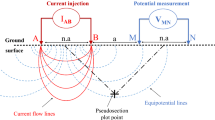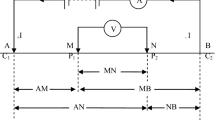Abstract
The direct current (DC) electrical resistivity (ϱ) of three timber species namelyEucalyptus teriticornis, Grevillea robusta andHevea brasiliensis grown as plantations in India has been measured at different moisture contents (MC) and at room temperature. The dependence of the resistivity on moisture content has been found to obey the relations of the type log (ϱ)=A+B log (MC) for the moisture contents ranging from fibre saturation point (fsp) to 10% and of the type log (ϱ)=C+D (MC) for the moisture contents below 10% for all the three species. The effects of grain direction and specific gravity on resistivity were also investigated.
Zusammenfassung
Der elektrische Widerstand (ϱ) von drei Holzarten,Eucalyptus teriticornis, Grevilles robusta undHevea brasiliensis, die in Plantagen in Indien wachsen, wurde bei unterschiedlichen Holzfeuchten und Raumtemperaturen untersucht. Die Abhängigkeit der Widerstandes von der Holzfeuchte folgte Beziehungen vom Typ: log (ϱ)=A+B log (MC) für Holzfeuchten im Bereich des Fasersättigungspunktes (FSP) bis zu 10%. Unterhalb 10% Feuchte folgte die Beziehung für alle drei Holzarten dem Gleichungstyp: log (ϱ)=C+D (MC). Der Einfluß von Faserrichtung und Rohdichte wurde ebenfalls untersucht.
Similar content being viewed by others
References
Anon (1986) Bureau of Indian Standard, “Methods of testing of small clear specimens of timber”, IS: 1708 (Parts 1–18), New Delhi
Brown JH, Davidson RW, Skaar C (1963) Mechanism of electrical conduction in wood, For. Prod. J. 13: 455–459.
Hartley ID, Schneider MH (1989) Modelling direct current resistivity of wood polymer composites, Wood Fibre Sci. 21: 411–19
James WL (1975) US For. Serv. Res. Pap. FPL-245
Lin RT (1965) A study of electrical conduction in wood, For. Prod. J. 15: 506–514
Lin RT (1967) Review of the electrical properties of wood and cellulose, Forest Prod. J. 17: 54–61
Pfaff F, Garrahan P (1984) Moisture content correction tables for resistance-type moisture meter, Report SP511E. Forinetek Canada Corp., Ottawa, Ontario, pp. 42
Shyamasundar K, Aswathanarayana BS (1993) Development of a prototype LED moisture indicator, J. Timb. Dev. Assoc., XXXIX, pp. 9–14
Simpson WT (1984) Resistance moisture meter correction factors for four tropical wood species, Res. Note, FRL-RN-0260, Madison, WI: US Department of Agriculture, Forest Science, Forest Products Laboratory, pp. 6
Skaar C (1964) Some factors involved in the electrical determination of moisture gradients in wood, For. Prod. J. 14: 239–244
Author information
Authors and Affiliations
Rights and permissions
About this article
Cite this article
Sharma, S.K., Shukla, S.R. & Kamala, B.S. Studies on DC electrical resistivity of plantation grown timbers. Holz als Roh- und Werkstoff 55, 391–394 (1997). https://doi.org/10.1007/s001070050252
Issue Date:
DOI: https://doi.org/10.1007/s001070050252




